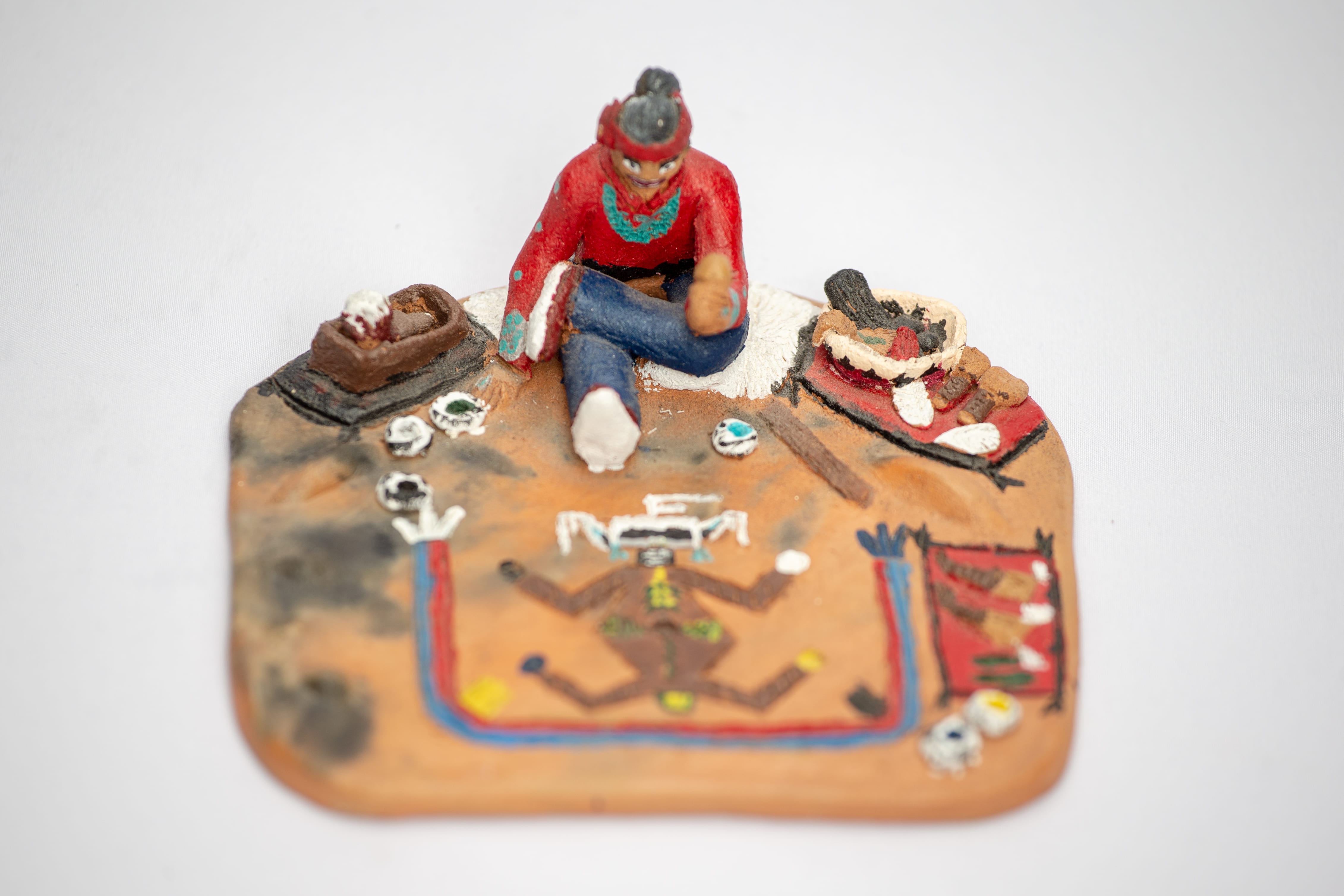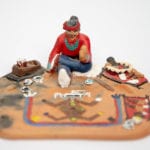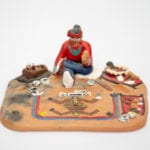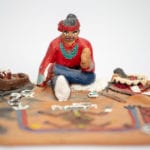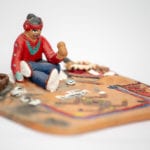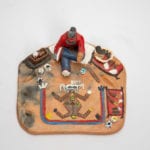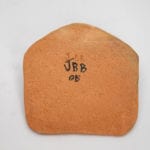I have seen thick, low-relief carved Navajo clay tiles, but never a Navajo tile like 2018-05 that is 1) this thin nor 2) one that was this fully three dimensional, nor 3) one that depicted Navajo ceremonial life.
Until recently, all Navajo pottery was utilitarian, corn-cob scraped and sealed with pinion pitch (cf 1969-07). Probably because they are a nomadic people, pottery making was not a major craft of the Navajo. In the 1970’s and 1980’s Navajo artists discovered that tourists would buy Navajo pottery if the artists fancied it up a bit. First appliqué figural forms were added (1991-08); then artists began describing Navajo life with a series of appliqué and painted figures (2005-11 and 2011-01). Then unusual. humorous shapes appeared: a frying pan with egg (2014-09) and herds of bears (2012-15 and 2017-02). A few Navajo potters produced sleek, elegant pottery that emphasized the beauty of form (1991-07 and 2013-11). This flowering of art is well-documented in Chuck and Jan Rosenak’s book The People Speak: Navajo Folk Art (1994). Even given this renaissance in Navajo ceramic art, until now I have not seen anything like tile 2018-05. Betty Manygoats is apparently related to “JBB,” the maker of this tile, but her tiles are thick and the shallow carving broad, as if the tile was made of a plank of wood with chiseled, low-relief figures.
In contrast, the base of tile 2018-05 is 0.1875″ thin and completely flat. (Handmade tiles tend to distort and warp as they dry.) On the back the initials JBB are inscribed into the surface and then repeated in black paint, with the number either “05” or “o6″ painted beneath to indicate the year of production. The tile depicts a Navajo chanter conducting a healing ceremony centered around a sand painting. Seated on a textured white blanket, the chanter is 1.75″ tall; the two large baskets on either side of him are 0.25″ and 0.50” tall. So small are other individual items that they are better seen in the enlarged photographs on this website than they are when seen directly.The chanter is traditional dressed: his hair is bundled in the back and is held in place with a headband. He is dressed in velveteen shirt, turquoise necklace, dark pants and moccasins. Eyes, nose and mouth are clearly drawn. Notice the extraordinary detail. The lips are red, surrounded by white with a black line border, all in a fraction of an inch. The string of the necklace continues around the neck; individual beads are indicated by indentations in the clay. Four conchos adorn his shirt; a silver concho belt encircles his waist. He sits left leg crossed over his right. A brown rattle in his left hand indicates his chanting.
To the man’s left is a rectangular rust-colored blanket, its identity indicated by painted black tassels on the two interior corners. On the blanket are two objects that appear to be black moccasins with beige interiors or toes. In front of them are two white fan-like objects that I believe are feathers. In the basket on the pillow are two round black objects and three other painted objects that may be bread or some other organic items. A flat piece of wood lies on the ground parallel to this blanket, followed by an unpainted object is the shape of an ear of corn. On the far left is a second rust-colored blanket, this one with four tassels. On it are etched two small green objects, perhaps chili pods. Next to them are two larger objects, identical in shape, whose identity I cannot guess. They appear to have yellow bases with white extensions, raised indented bodies and etched tassels that are brown. Finally, to man’s far left are two final white bowls holding colored sand.
Immediately to the man’s right is a square container that may represent a stone grinding bin with three grinding stones of different sizes, the largest caped by a white material, perhaps corn. Sacred ground corn is an essential element in a healing ceremony. In front of this square bin are are three small bowls that are painted white with black edging, some with painted interiors. Of the six such bowls in this tableau, one holds yellow sand, one turquoise blue, one white and three hold black sand. Behind the three bowls to his right is a long unpainted lump like the one between the two blankets of the man’s left. Further away from him on his right are three more smaller unpainted lumps. Why the artist did not paint these, having done so much detailed painting already, I have no idea.
At the center of the tile is a sandpainting of Mother Earth surrounded on three sides by a rainbow yei (spirit deity), its body composed of red and blue stripes, its ends caped with what appear to be white and black feathers. A rainbow yei is drawn around every sandpainting his body curling around the south, west and north sides to protect the painting from outside evil and protect the chanter and client from the power of the god depicted. The yei is not needed on the east because no evil can come from the direction of the rising sun.
The body of Mother Earth is brown, like soil. Her arms and legs are extended, incised with lines, and end with round depressions with a small cross at the bottom. Her left foot is yellow; her left hand is painted white. Her right foot is black and right hand either unpainted or incompletely painted black. She carries a headdress of white and turquoise blue; her face is crudely painted white with a black mask. Her bellybutton is a hole that does not go through the tile. In contrast to the face, the trunk of Mother Earth is carefully drawn. Below the central hole is a thin green vine, seven dots indicating leaves. To the right and left of the bellybutton is additional green foliage shaped like a fan with small indentations providing texture. Above the central hole is a precisely-drawn corn plant with three pairs of leaves, six ears of corn where the leaves attach to the stalk, all topped with a yellow tassel.
Notice that while the base tile is roughly 5″ X 5″, my description of the design has taken far more than the equivalent space on a computer screen. The tile is extraordinarily detailed and it simply takes more words to describe it than it does to see it.
Much of what takes place in a chant ceremony is secret and should not be shared with outsiders. I have only a simple understanding of Navajo religious beliefs. As I understand the scene on tile 2018-05, when a chanter is called to perform a “sing”, or healing ceremony for a person who is sick, he must relate the history of the Navajo people and the necessary harmony of the people with the world. Individual sickness is the result of a person becoming out of balance; a failure to maintain reciprocal responsibilities with the environment, infringement of ceremonial rules, and transgressions against one’s own mind and body. The ceremony depicted on tile 2018-08 is designed to restore the interconnectedness of all life, thus healing both the world and the sick person whose family requested the ceremony. The sandpainting is a place of entry where supernatural beings enter and leave, attracted by their likenesses in the painting. The establishment of this pathway lets the evil or illness in the patient be replaced by the good, or healing power of the supernatural being. (Explanation courtesy of Twin Rocks Trading Post, Bluff, Utah.)
Most Navajo potters live in the western section of the large Navajo reservation, particularly around the villages of Shonto and Cow Springs, both northeast of Tuba City. Presumably tile 2018-05 was made in this area.

